Aylward, Margaret (1810-1889)
At the dawn of the nineteenth century, Margaret Aylward, daughter of William and Ellen (nee Murphy) Aylward was born in 1810. Born into privilege, she was the fifth of eleven children. Margaret’s first address was 11 Thomas Street, Waterford. Her first educational experience was at a local Quaker school. It was during this period that John Gowan, CM (1817-1889), from Skerries in Dublin, was born. This is significant as he became Margaret’s lifelong spiritual director and mentor throughout her adult life. Gowan would become a Vincentian priest and advised Margaret in the work of St. Brigid’s Orphanage and the Sisters of the Holy Faith.
The 1840s experienced An Gorta Mór (Great Famine). The occurrence of a potato crop failure countrywide and the ensuing famine and disease epidemic engulfed the landscape. The poorest of rural areas were devastated and harbours in Waterford and Dublin were swarming with fraught exiles and desperate refugees, arriving from the Irish countryside. During this famine, Margaret travelled to Dublin and witnessed first-hand the purge of human life and scenes of absolute poverty in the nation’s capital. The story of Margaret Aylward, in many ways, represents nineteenth-century Ireland. The geography and economy of the island, coupled with the experience of two famines and the inevitable measurement of death, disease, and mass exodus, draws an illustrative map of what Ireland was like during that time period.
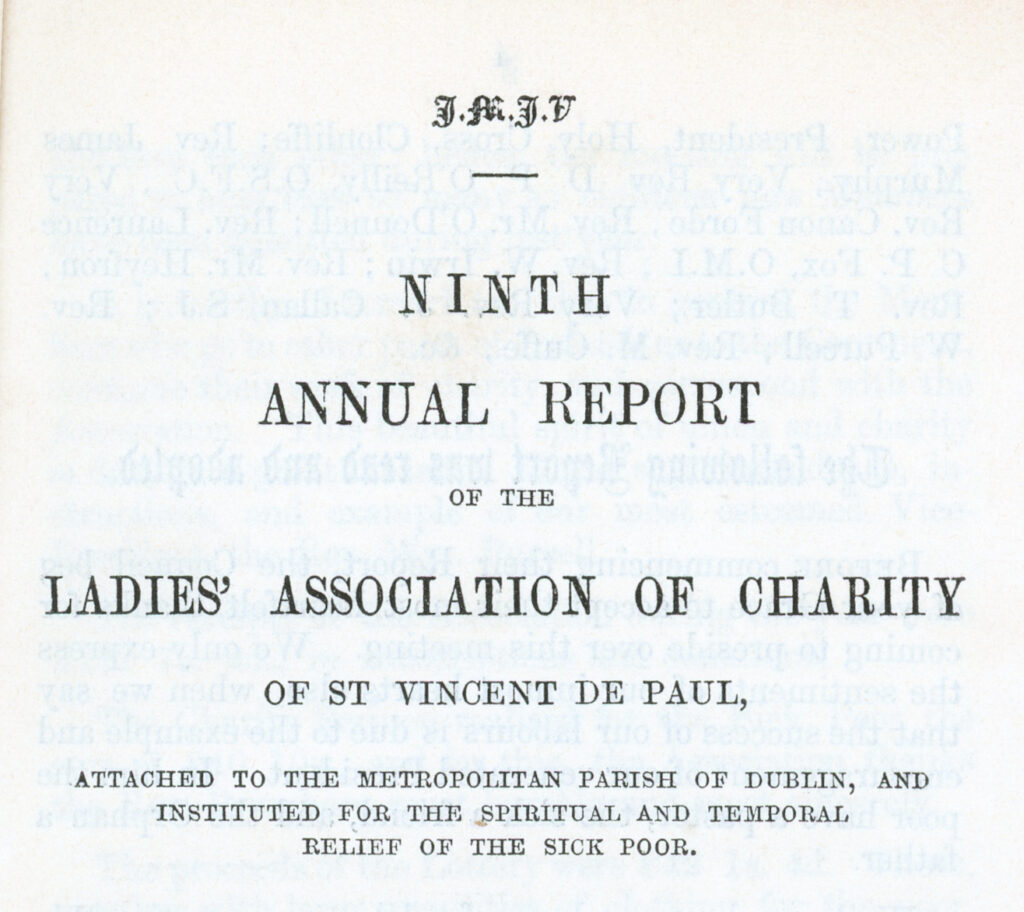
‘But, how much of human suffering is prevented, how much of human woe is alleviated by the visits and the attentions paid to the poor! Sometimes the poor drunkard listens to the gentle rebuke and kind remonstrance of the Lady of Charity. Sometimes differences are settled, and neighbours are reconciled, and blessed peace that had departed, returns with the visit of the Lady of Charity. But, the generous natures, the keen perception, the sympathetic heart of our Irish poor, are always alive to the kindness done them. Hence, when they see our Ladies visiting them, instructing them, prayer with them, feeling for them, they become relieved indeed, a light breaks in upon their souls, joy beams in their countenances, and they forget for a time their miseries’ (Ninth Annual Report of the Ladies’ Association of Charity of St. Vincent de Paul, 1860).
According to Jacinta Prunty, Margaret’s ‘first structured work among the poor … was through the Ladies’ Association of Charity of St. Vincent de Paul for the Spiritual and Temporal Relief of the Sick Poor’ (1999, 22). Prunty further notes that while Aylward maintained a connection with a Ladies’ Association branch in Waterford, ‘her first recorded active involvement was with the Kingston group (Dún Laoghaire) which was headed by a Miss Margaret Kelly. By May 1851, Margaret Aylward had founded her own branch in the Metropolitan Parish of St. Mary’s Marlborough Street’ [Dublin] (1999, 22).
Aylward’s mission for the Ladies’ Association of Charity was the Relief of the Sick Poor; and to stem the spread of Protestantism by providing dietary, spiritual, and educational nourishment to the Catholic poor. Here, she laid out the structure of the Association by developing short and long-term objectives. Critically, Aylward documented the Association’s mission, confronted challenges, provided a vivid description of Dublin’s insurmountable poverty, and provided an illustrative roadmap on how to solicit funds.
From the beginning, Margaret put her entrepreneurial skills to the test with the Ladies’ by establishing St. Mary’s Industrial Institute (Upper Dorset Street, Dublin) as a sewing factory and training center for women. It also contained a creche. Although short-lived, Margaret believed in the value of female employment and supported opportunities that enabled women to work. There is some mention of this work in the Annual Reports of the Ladies’ Association of Charity of St. Vincent de Paul (1853-1854).
The Ladies’ would also provide the support and connections to establish St. Brigid’s Orphanage which held its first meeting on 16 January 1857. Through this, Aylward cultivated the importance of foster care, education, and Roman Catholicism. The journey of St. Brigid’s Orphanage is vividly documented in the Annual Reports of St. Brigid’s Orphanage.
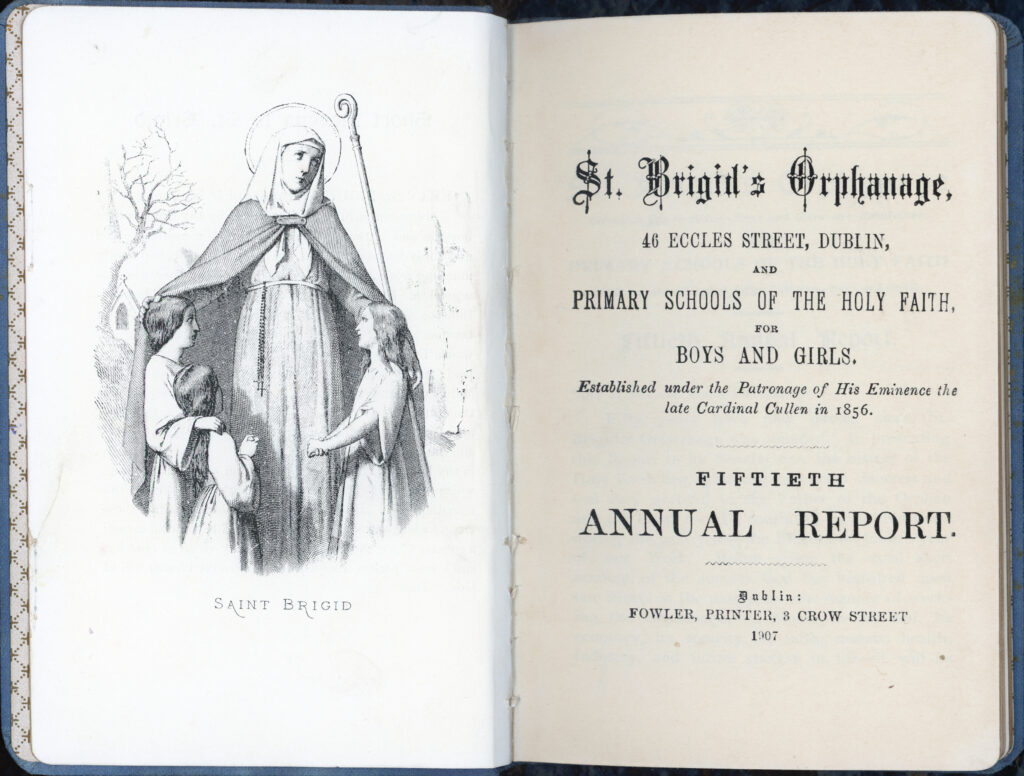
‘St. Brigid’s being a country or home orphanage its success depends principally on the character of the nurse and of the home. The child is morally as well as physically affected by its surroundings. It is then, as we have frequently stated, only in those families where we find evidence of faith, of motherly care and kindness as well as of industry, that we place out children to have their character and habits properly formed….far from tiring of the work, these good women, full of faith and good nature, feel it an honour to be engaged in it, and seem to become more devoted and zealous every day’ (Fiftieth Annual Report of St. Brigid’s Orphanage, 1906)
Margaret believed in and steadfastly remained committed to a boarding-out system. This system encouraged foster care and country living. Here, orphans were boarded-out to nurses (foster parents) and funds were assiduously raised in order to pay the nurses premiums. Remuneration revolved around progress a child made with regard to knowledge of prayers, basic literacy skills and whether a child received his or her sacraments.
The early 1860s witnessed a turbulent beginning for Margaret. In November 1861, Margaret Aylward was confined by the Court of Queen’s Bench to six months imprisonment in Grangegorman Prison, and ordered to pay all costs over the alleged abduction of a child named Mary Mathews from St. Brigid’s Orphanage. Newspaper coverage was widespread in London and Dublin, with most of it vicious. However, despite the ill-treatment she received in prison and her suffering from a myriad of physical ailments, Margaret Aylward forged ahead and persevered.
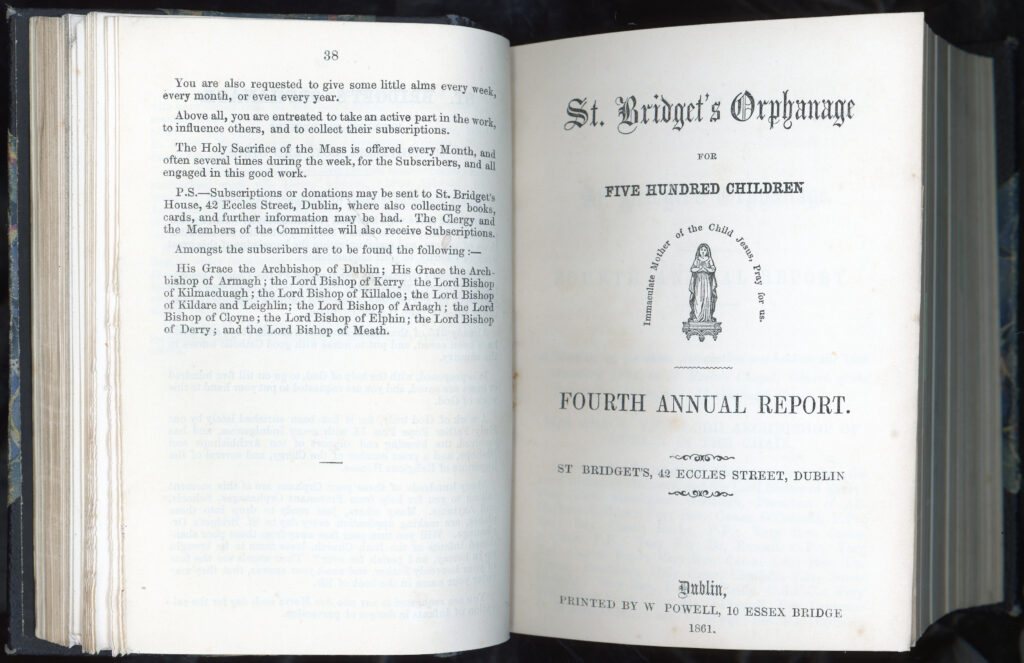
‘During her imprisonment she directed arrangements for the fourth annual meeting of St. Brigid’s Orphanage, which was rescheduled for 16 January 1861. It was a provocative display of clerical support, with Archbishop Cullen in the chair, flanked by the bishops of Kerry and Dromore, and an impressive array of high-ranking clergymen. Ostensibly to launch the fourth report and encourage the members in their charitable endeavours, it was an occasion to publicly show support for the imprisoned “lady manager” and a platform for speeches defending St. Brigid’s against counter-charges of proselytism. Margaret planned the meeting from her prison cell’ (Prunty, 1999, 95).
Nonetheless, despite her best efforts to direct activities for both the Ladies’ of Charity and St. Brigid’s Orphanage from Grangegorman prison, when Margaret was released in May 1861, she came home to find that her group had dissolved with most of her helpers deserting.According to Prunty, this breakup pertained to ‘the Daughters of Charity of St. Brigid, the lay community of six women…[who] formed the core of the Ladies’ of Charity and the Committee of Management of St. Brigid’s Orphanage’ (1999, 99). An exception was Ada Allingham (aged 22) from 98 Capel St. in Dublin, who was a boarder in the Sienna Convent in Drogheda, and an elderly Eliza Monahan who hailed from Galway.
The 1860s also saw Margaret shepherding the establishment of several St. Brigid’s schools. Following her release from prison, Aylward established the first school in 1861 through the Ladies’ of Charity and St. Brigid’s Orphanage. These schools then came under the direction of the Sisters of the Holy Faith (Holy Faith schools) from the late 1860s. Margaret, as seen by her writings in the Annual Reports of St. Brigid’s Orphanage vehemently opposed state aid and state involvement in education, particularly within the realm of Holy Faith schools. Prunty suggests that Margaret viewed national state-controlled education ‘as a way of subverting the traditional right of the Catholic church to educate its own adherents, also provided grounds for suspicion’ (1999, 106). However, it was to be a losing battle, due in part to the establishment of the Commissioners of National Education.
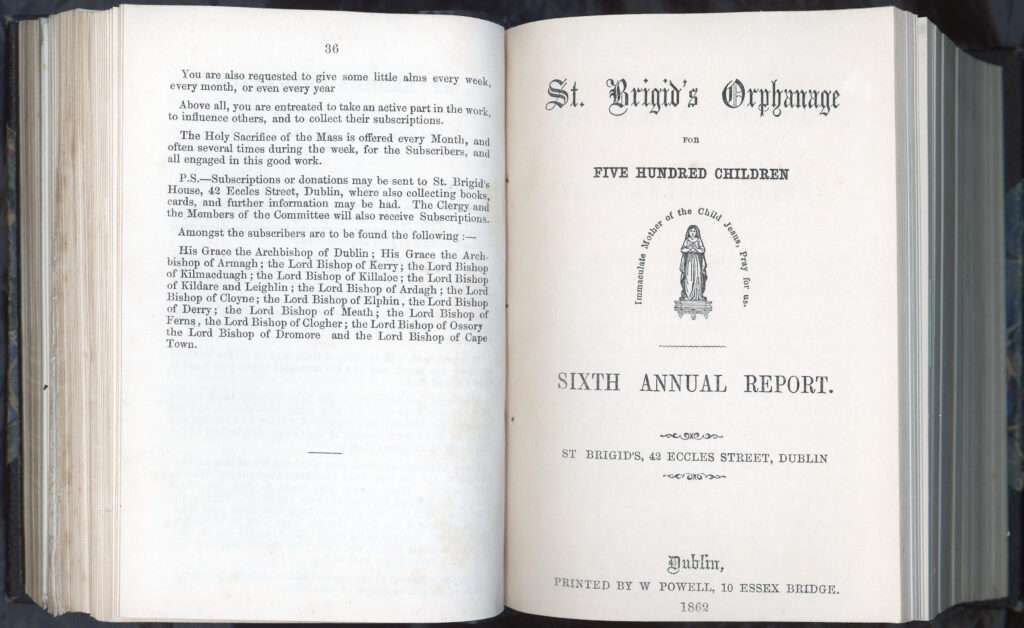
‘Amidst the perils which encompass Catholic education at the present moment, Ireland will find her greatest security by fostering this spirit and relying upon herself. English statements present a subsidy for education with one hand, and a manacle with the other; he who accepts the one is bound fast by the other and becomes a slave. Coming events should be read by the light of the past, and independence, especially in primary education, secured at any sacrifice’ (Sixth Annual Report of St. Brigid’s Orphanage, 1862).
Besides the influx of state involvement in Irish education, the influence of Protestantism also imbues the era. In her article titled Dangers to Faith (1862), Margaret wrote about the encroaching elements of Protestantism: ‘In former reports we enumerated many of the institutions, schools and artifices by which Catholic children are robbed of their faith. It is not necessary to name these again, for, thank God, every Catholic who values his faith admits now the necessity of constant vigilance and incessant exertion to save our poor children from heresy’ (Sixth Annual Report of the Ladies’ Association of Charity of St. Vincent de Paul, 1857).
In 1865, at the behest of the Archbishop, Dr Paul Cullen, Glasnevin House and the surrounding 45 acres was purchased by Margaret Aylward. Owned by the Sacred Heart Sisters, they had relocated to Mount Antville due to inadequate space at Glasnevin. In 1866, Aylward wrote to the Cardinal requesting the society may be called the Congregation of the Holy Faith, after a formal application for Canonical Erection occurred. This was the formal request to become a religious sisterhood under the title the Congregation of the Sisters of the Holy Faith. According to Prunty, Aylward’s ‘decision to allow her group be formed into a religious congregation was intimately bound up with her hopes for the enlargement of this Catholic poor school network, and her determination to maintain the unpaid character of all her charitable work’ (1999, 121).
Margaret and companions made religious vows in the oratory (Glasnevin) and wore religious habits. Eliminating any confusion regarding the religious status of Margaret, Sister Agnes Vicars, Margaret’s successor, stated that Margaret was in fact a nun. Margaret, who took her vows on 15 August 1866, was permitted to wear lay dress. This was a practical matter and was due to her hands-on approach in working with the poor. Glasnevin Convent would go on to become the Mother House of the Sisters of the Holy Faith, which encompassed a teacher-training college, and an established body of Holy Faith schools.
For illustrative purposes and for the viewers benefit, it would be satisfactory if a portrait of Margaret endured. Unfortunately, no photograph exists. Although there are a couple of drawings; each illustrating a different rendition, contemporary reflection surmises that perhaps Margaret had a dislike of self-portraits-due in part to her suffering a lifetime infliction of erysipelas (skin disease).
Margaret Aylward died in 1889 and was buried in the Glasnevin Convent Cemetery. Sister M. Agnes Vicars was appointed Superior General of the Congregation of the Sisters of the Holy Faith. Following her death, Fr John Gowan pays homage to Margaret Aylward, and provides an account of her in life in the Thirty-Third Annual Report of St. Brigid’s Orphanage (1889).
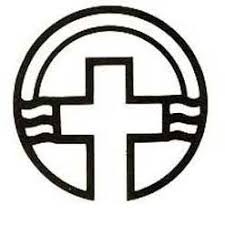
‘We are indebted in a great measure for all these blessings to Miss Aylward, who, strong in faith, came to our assistance in hard times, and pitched a Catholic camp on the hill yonder, right opposite the enemy’s stronghold’ (Thirty-Third Annual Report of St. Brigid’s Orphanage, 1889).
Margaret Aylward was a witness to Catholic Emancipation, the Home Rule League and the Irish National Land League. She experienced famine, disease, and despair. She faced the rise in immigration, government control over education and the decline in the Irish population and native language. Despite these tumultuous events, Margaret Aylward left an indelible footprint in education and assisting the downtrodden. Her single-mindedness in alleviating the suffering of the poor and promoting the enduring value of education, lives on today. The list of Holy Faith schools is impressive as are the copious numbers of individuals and families she aided. She possessed innumerable personality traits, all of which elicits admiration. Aylward’s tenacity, perseverance, intellect and business acumen was remarkable. However, above all else, it was her faith in humanity that persevered; all of which is manifestly embedded in Annual Reports of the Ladies’ of Charity and St. Brigid’s Orphanage.
References
Prunty, Jacinta (1999) Margaret Aylward: Lady of Charity, Sister of Faith 1810-1889, Four Courts Press, Dublin.
Other Reading
Gibbons, Margaret (1928) The Life of Margaret Aylward: Foundress of the Sisters of the Holy Faith, Sands and Company, London.
Townend, Paul. A, (2000) ‘Margaret Aylward, 1810-1889: Lady of Charity, Sister of Faith,’ The Catholic Historical Review.
Cullen, Mary, and Luddy, Maria (1995), Women, power, and consciousness in 19th-century Ireland: eight biographical studies, Attic Press, Dublin.
Prunty, Jacinta (2019) ‘Battle plans and battlegrounds: Protestant mission activity in the Dublin slums-Protestant Millennialism, Evangelicalism and Irish Society, 1790-2005’, The Journal of Ecclesiastical History, Vol. 70, No. 4.
Prunty, Jacinta (2017) Our Lady of Charity in Ireland, Columba Press, Dublin.
Collection Description
La Pina, Helena (2020) ‘About Margaret Aylward’, Holy Faith Digital Archive, available: http://hfsdigitalarchive.org/about-margaret-aylward/.
